Experimental Study of a Hybrid Solar Collector Using TiO2/Water Nanofluids
Abstract
:1. Introduction
2. Experimental Study Procedure
3. Analytical Methodology
- Steady-state operation.
- The inlet mass flow rate into the solar thermal storage tank is constant.
- The radiation heat transfer is negligible.
- The dust deposition on the solar panel is meager.
3.1. Performance of Electrical Energy
3.2. Performance of Thermal Energy
3.3. Uncertainty Analysis
4. Results and Discussion
5. Conclusions
Author Contributions
Funding
Institutional Review Board Statement
Informed Consent Statement
Data Availability Statement
Conflicts of Interest
References
- Mehrali, M.; Latibari, S.T.; Rosen, M.A.; Akhiani, A.R.; Naghavi, M.S.; Sadeghinezhad, E.; Metselaar, H.S.C.; Nejad, M.M.; Mehrali, M. From rice husk to high-performance shape stabilized phase change materials for thermal energy storage. RSC Adv. 2016, 6, 45595–45604. [Google Scholar] [CrossRef] [Green Version]
- Dursun, B. Determination of the optimum hybrid renewable power generating systems for the Kavakli campus of Kirklareli University, Turkey. Renew. Sustain. Energy Rev. 2012, 16, 6183–6190. [Google Scholar] [CrossRef]
- Jun, Z.; Junfeng, L.; Jie, W.; Ngan, H.W. A multi-agent solution to energy management in a hybrid renewable energy generation system. Renew. Energy 2011, 36, 1352–1363. [Google Scholar] [CrossRef]
- Bahaidarah, H.M.; Baloch, A.A.; Gandhidasan, P. Uniform cooling of photovoltaic panels: A review. Renew. Sustain. Energy Rev. 2016, 57, 1520–1544. [Google Scholar] [CrossRef]
- Chandel, S.S.; Agarwal, T. Review of cooling techniques using phase change materials for enhancing efficiency of photovoltaic power systems. Renew. Sustain. Energy Rev. 2017, 73, 1342–1351. [Google Scholar] [CrossRef]
- Chauhan, A.; Tyagi, V.V.; Anand, S. Futuristic approach for thermal management in solar PV/thermal systems with possible applications. Energy Convers. Manag. 2018, 163, 314–354. [Google Scholar] [CrossRef]
- Nadda, R.; Kumar, A.; Maithani, R. Efficiency improvement of solar photovoltaic/solar air collectors by using impingement jets: A review. Renew. Sustain. Energy Rev. 2018, 93, 331–353. [Google Scholar] [CrossRef]
- Shukla, A.; Kant, K.; Sharma, A.; Biwole, P.H. Cooling methodologies of photovoltaic module for enhancing electrical efficiency: A review. Sol. Energy Mater. Sol. Cells 2017, 160, 275–286. [Google Scholar] [CrossRef]
- Hasanuzzaman, M.; Malek, A.B.M.A.; Islam, M.M.; Pandey, A.K.; Rahim, N.A. Global advancement of cooling technologies for PV systems: A review. Sol. Energy 2016, 137, 25–45. [Google Scholar] [CrossRef]
- Chol, S.; Estman, J. Enhancing thermal conductivity of fluids with nanoparticles. ASME-Publications-Fed 1995, 231, 99–106. [Google Scholar]
- Sridhara, V.; Satapathy, L.N. Al2O3-based nanofluids: A review. Nanoscale Res. Lett. 2011, 6, 456. [Google Scholar] [CrossRef] [PubMed] [Green Version]
- Hemmat, M.E.; Karimipour, A.; Yan, W.-M.; Akbari, M.; Safaei, M.R.; Dahari, M. Experimental study on thermal conductivity of ethylene glycol based nanofluids containing Al2O3 nanoparticles. Int. J. Heat Mass Transf. 2015, 88, 728–734. [Google Scholar] [CrossRef]
- Ebrahimnia-Bajestan, E.; Moghadam, M.C.; Niazmand, H.; Daungthongsuk, W.; Wongwises, S. Experimental and numerical investigation of nanofluids heat transfer characteristics for application in solar heat exchangers. Int. J. Heat Mass Transf. 2016, 92, 1041–1052. [Google Scholar] [CrossRef]
- Minea, A.A. Hybrid nanofluids based on Al2O3, TiO2 and SiO2: Numerical evaluation of different approaches. Int. J. Heat Mass Transf. 2017, 104, 852–860. [Google Scholar] [CrossRef]
- Wu, X.; Wu, H.; Cheng, P. Pressure drop and heat transfer of Al2O3-H2O nanofluids through silicon microchannels. J. Micromech. Microeng. 2009, 19, 105020. [Google Scholar] [CrossRef]
- Sardarabadi, M.; Passandideh-Fard, M.; Heris, S.Z. Experimental investigation of the effects of silica/water nanofluid on PV/T (photovoltaic thermal units). Energy 2014, 66, 264–272. [Google Scholar] [CrossRef]
- Ghadiri, M.; Sardarabadi, M.; Passandideh-Fard, M.; Moghadam, A.J. Experimental investigation of a PVT system performance using nano ferrofluids. Energy Convers. Manag. 2015, 103, 468–476. [Google Scholar] [CrossRef]
- Sardarabadi, M.; Passandideh-Fard, M. Experimental and numerical study of metaloxides/ water nanofluids as coolant in photovoltaic thermal systems (PVT). Sol. Energy Mater. Sol. Cells 2016, 157, 533–542. [Google Scholar] [CrossRef]
- Al-Shamani, A.N.; Sopian, K.; Mat, S.; Hasan, H.A.; Abed, A.M.; Ruslan, M.H. Experimental studies of rectangular tube absorber photovoltaic thermal collector with various types of nanofluids under the tropical climate conditions. Energy Convers. Manag. 2016, 124, 528–542. [Google Scholar] [CrossRef]
- Soltani, S.; Kasaeian, A.; Sarrafha, H.; Wen, D. An experimental investigation of a hybrid photovoltaic/thermoelectric system with nanofluid application. Sol. Energy 2017, 155, 1033–1043. [Google Scholar] [CrossRef]
- Al-Waeli, A.H.; Chaichan, M.T.; Kazem, H.A.; Sopian, K. Comparative study to use nano-(Al2O3, CuO, and SiC) with water to enhance photovoltaic thermal PV/T collectors. Energy Convers. Manag. 2017, 148, 963–973. [Google Scholar] [CrossRef]
- Al-Waeli, A.H.; Sopian, K.; Chaichan, M.T.; Kazem, H.A.; Hasan, H.A.; Al-Shamani, A.N. An experimental investigation of SiC nanofluid as a base-fluid for a photovoltaic thermal PV/T system. Energy Convers. Manag. 2017, 142, 547–558. [Google Scholar] [CrossRef]
- Aberoumand, S.; Jafarimoghaddam, A. Mixed convection heat transfer of nanofluids inside curved tubes: An experimental study. Appl. Therm. Eng. 2016, 108, 967–979. [Google Scholar] [CrossRef]
- Aberoumand, S.; Jafarimoghaddam, A. Experimental study on synthesis, stability, thermal conductivity and viscosity of Cu–engine oil nanofluid. J. Taiwan Inst. Chem. Eng. 2017, 71, 315–322. [Google Scholar] [CrossRef]
- Srimanickam, B.; Saranya, A. Thermal Performance of Single Glazing Flat Plate Photovoltaic Thermal Hybrid System with Various Air Channels. J. Test. Eval. 2019, 49, 2119–2150. [Google Scholar] [CrossRef]
- Azam, M. Effects of Cattaneo-Christov heat flux and nonlinear thermal radiation on MHD Maxwell nanofluid with Arrhenius activation energy. Case Stud. Therm. Eng. 2022, 34, 102048. [Google Scholar] [CrossRef]
- Azam, M.; Abbas, Z. Recent progress in Arrhenius activation energy for radiative heat transport of cross nanofluid over a melting wedge. Propuls. Power Res. 2021, 10, 383–395. [Google Scholar] [CrossRef]
- Azam, M.; Mabood, F.; Khan, M. Bioconvection and activation energy dynamisms on radiative sutterby melting nanomaterial with gyrotactic microorganism. Case Stud. Therm. Eng. 2022, 30, 101749. [Google Scholar] [CrossRef]
- Azam, M. Bioconvection and nonlinear thermal extrusion in development ofchemically reactive Sutterby nano-material due to gyrotactic microorganisms. Int. Commun. Heat Mass Transf. 2022, 130, 105820. [Google Scholar] [CrossRef]
- Srimanickam, B.; Vijayalakshmi, M.M.; Natarajan, E. Energy and exergy efficiency of flat plate PVT collector with forced convection. J. Test. Eval. 2017, 46, 783–797. [Google Scholar] [CrossRef]
- Aberoumand, S.; Ghamari, S.; Shabani, B. Energy and exergy analysis of a photovoltaic thermal (PV/T) system using nanofluids: An experimental study. Sol. Energy 2018, 165, 167–177. [Google Scholar] [CrossRef]
- Wolf, M. Performance analysis of combined heating and photovoltaic power systems for residences. Energy Convers. Manag. 1976, 16, 79–90. [Google Scholar] [CrossRef]
- Salem, M.R.; Elsayed, M.M.; Abd-Elaziz, A.A.; Elshazly, K.M. Performance enhancement of the photovoltaic cells using Al2O3/PCM mixture and/or water cooling-techniques. Renew. Energy 2019, 138, 876–890. [Google Scholar] [CrossRef]
- Yunus, A.; Cengel, M.; Boles, A. Thermodynamics, An Engineering Approach, 6th ed.; Tata Mc Graw-Hill: New Delhi, India, 2009. [Google Scholar]

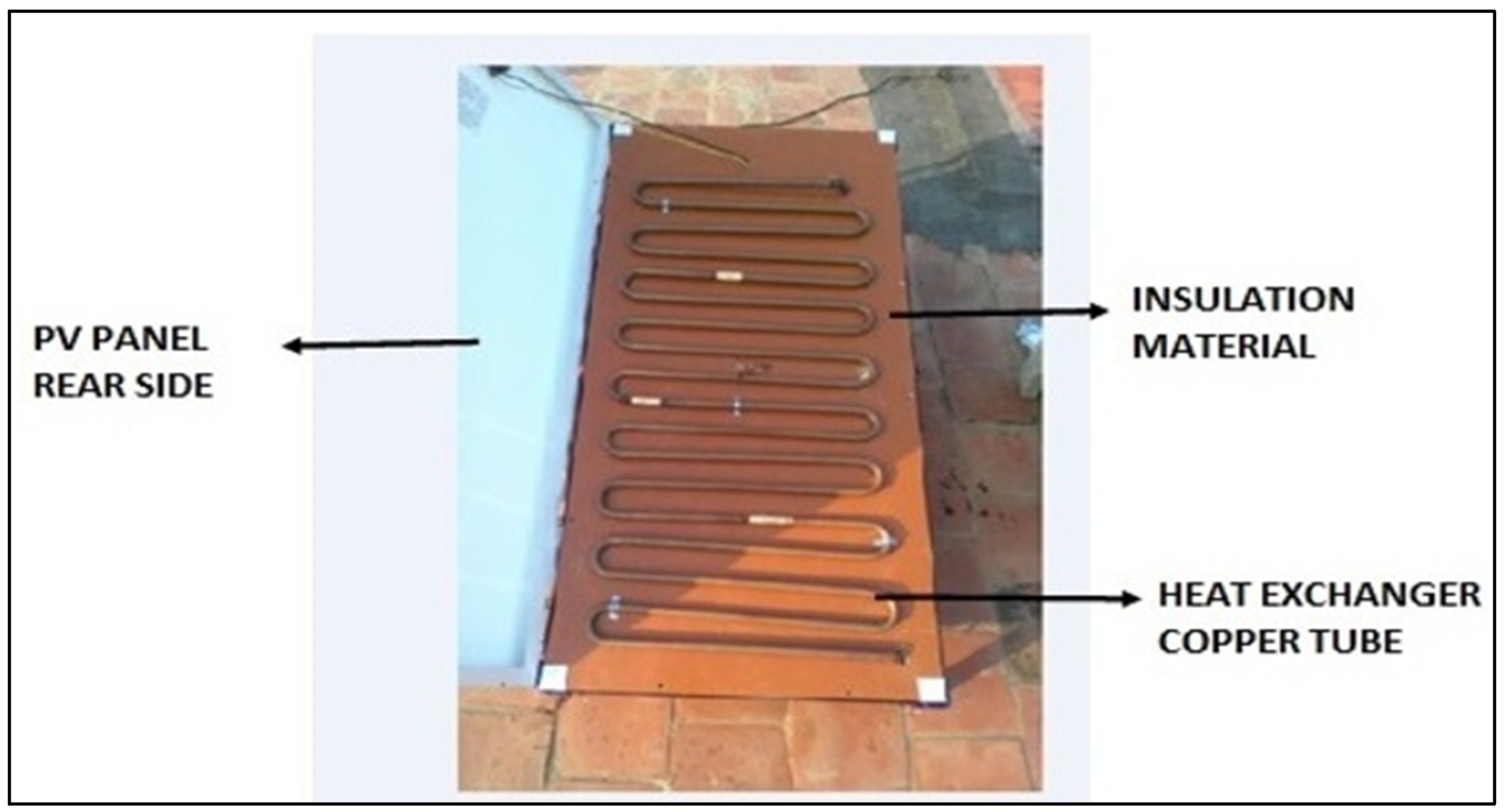
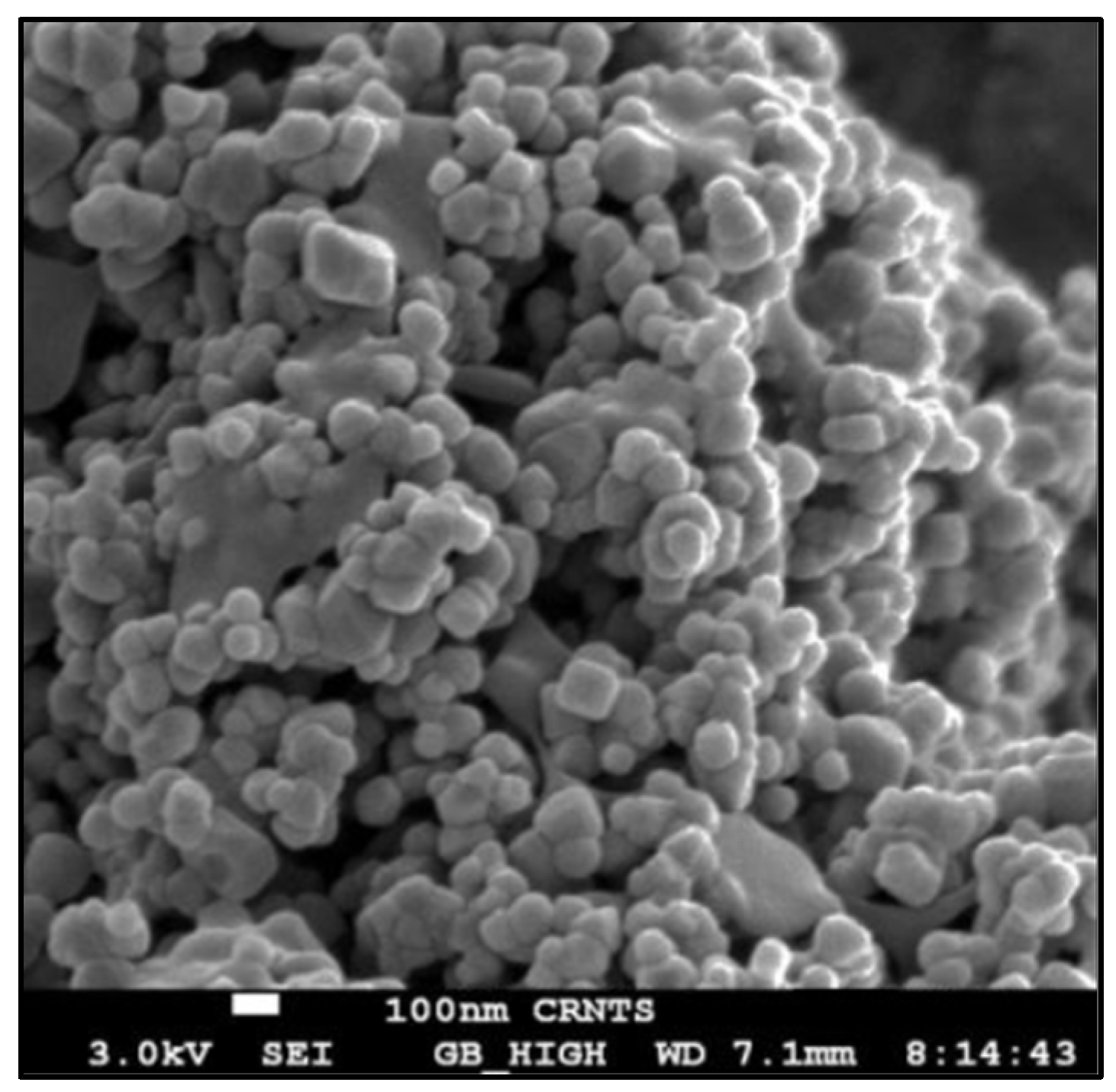


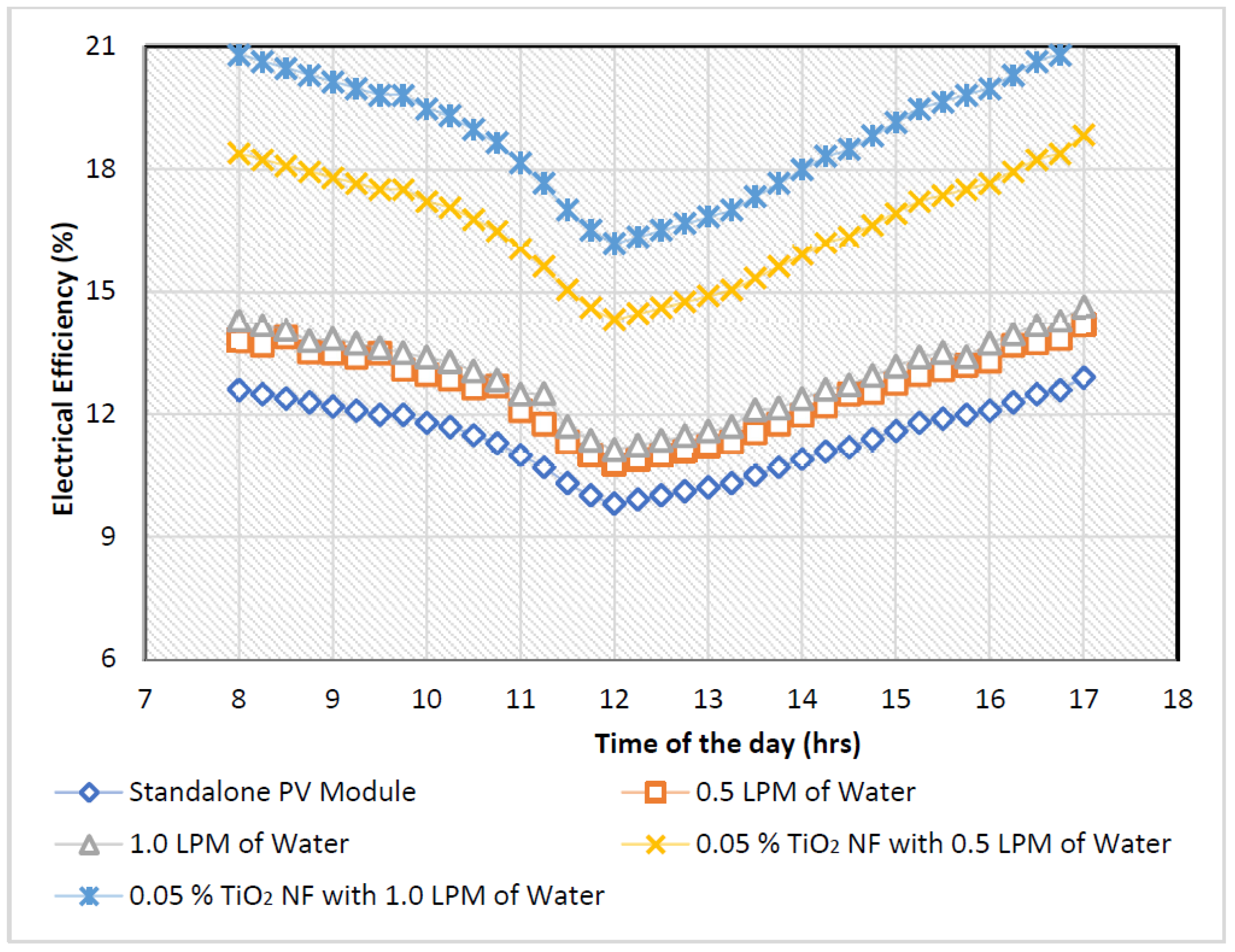


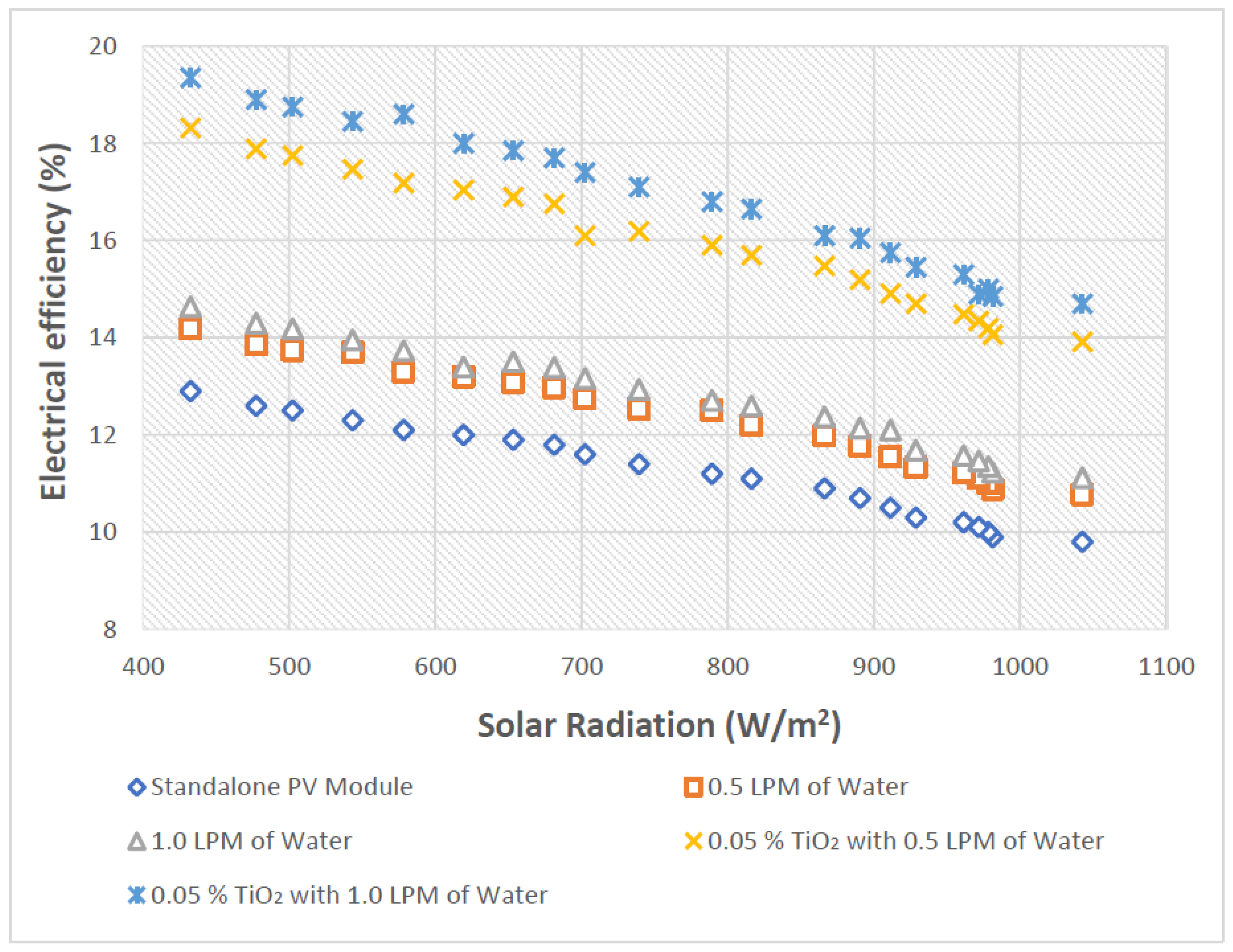
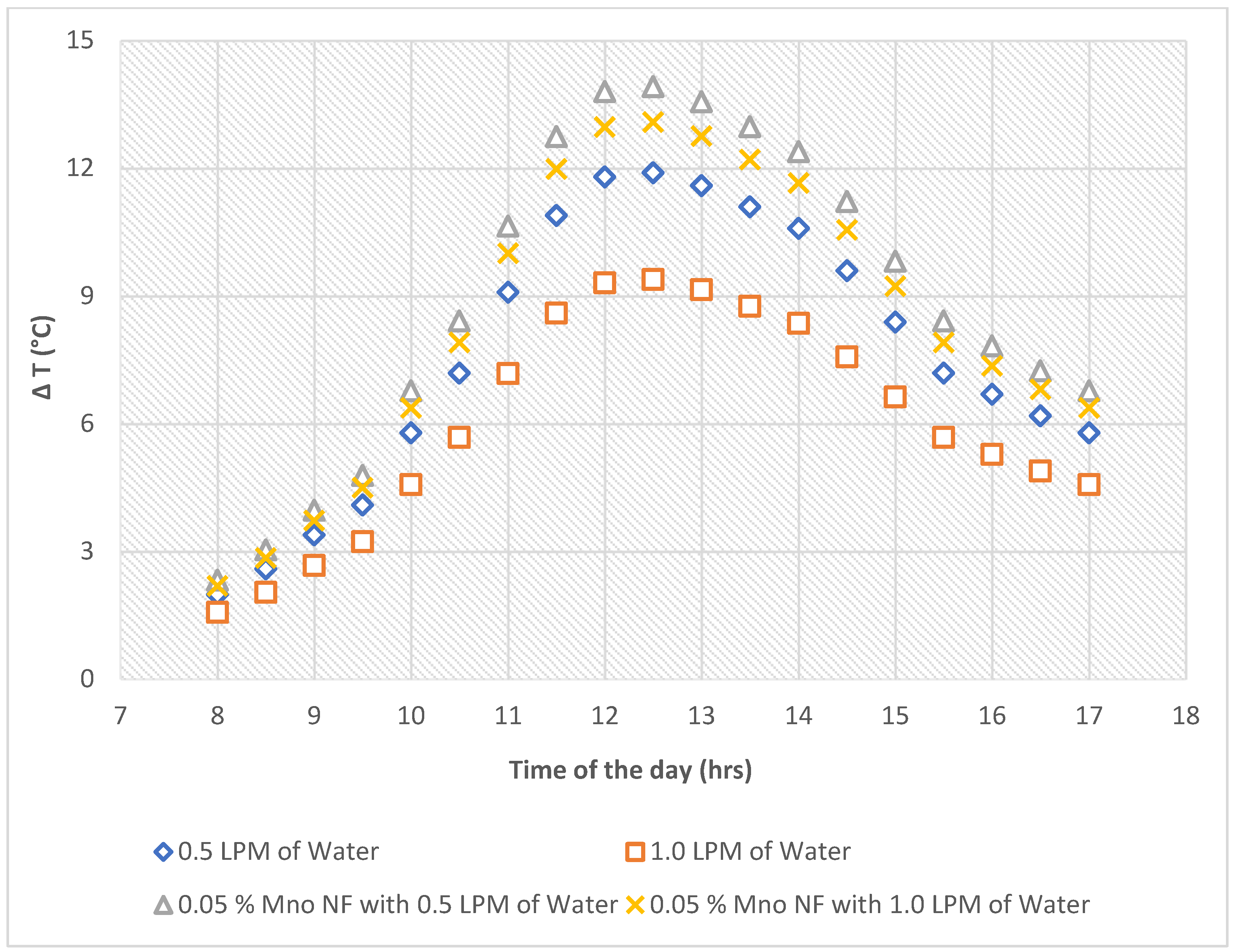
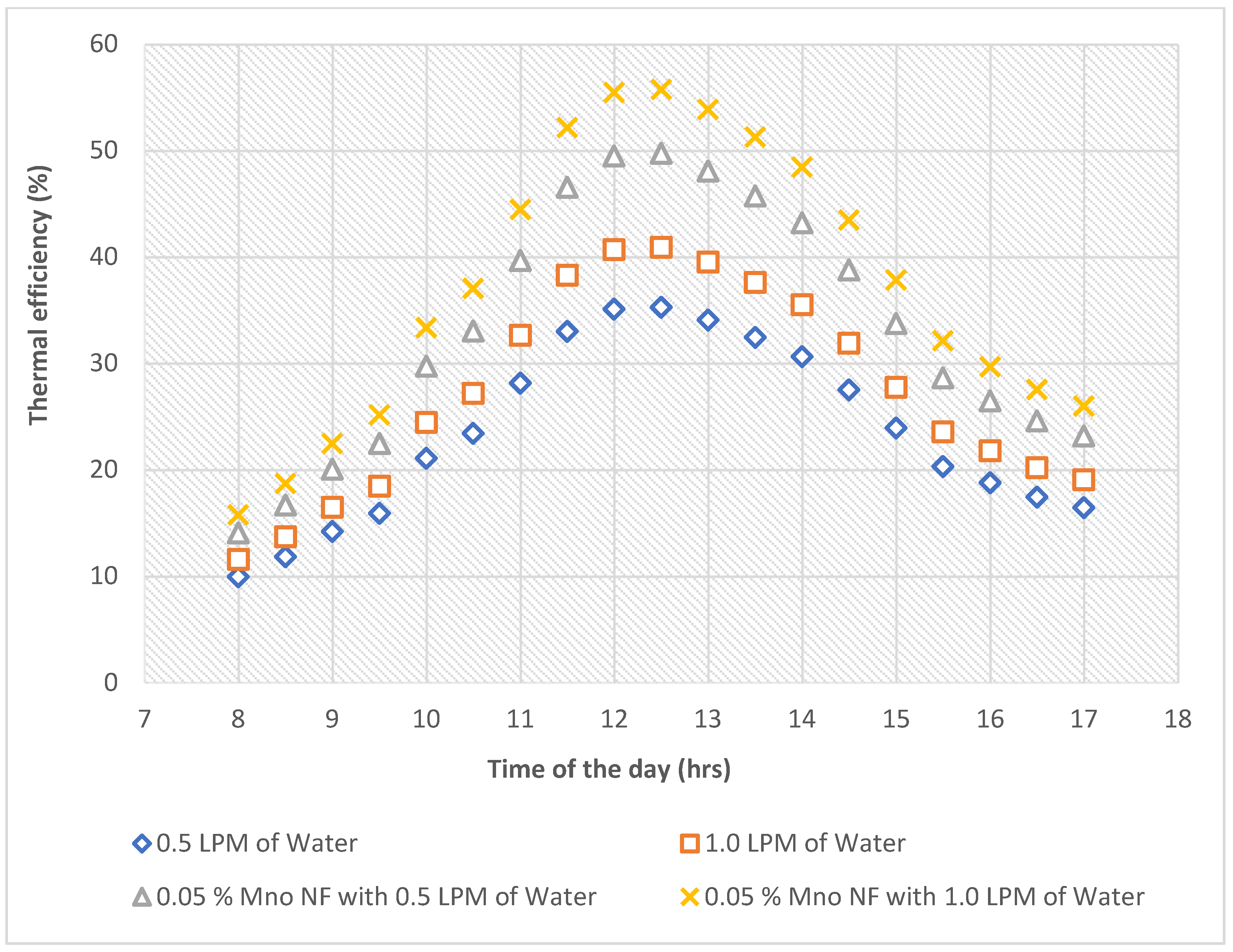
| Parameter | Value | Unit |
|---|---|---|
| Pmax | 260 | Watts |
| Amps in Pmax | 8.42 | Amps |
| Volts in Pmax | 30.9 | Volts |
| Current in Maximum Load | 8.89 | Amps |
| Voltage in Maximum Load | 37.7 | Volts |
| Weight | 18.2 | Kilogram |
| Sensor | Distortion | Type |
|---|---|---|
| Ambient air temperature | ±0.2 °C | K-thermocouple |
| Heat pipe temperature | ±0.2 °C | K-thermocouple |
| Rotameter | ±2.3% | UKL |
| Solar power meter | ±4 W/m2 | TM-206 |
| Inlet & outlet temperature | ±0.2 °C | K-thermocouple |
| Data logger | ±3.4% | Agilent 34980A |
| Sl. No | Working Fluid | Thermal Efficiency (%) | |
|---|---|---|---|
| Average | At Extreme Solar Radiation | ||
| 1 | 0.5 LPM | 25.76% | 35.31% |
| 2 | 1.0 LPM | 29.88% | 40.96% |
| 3 | 0.05% TiO2 with 0.5 LPM | 36.32% | 49.79% |
| 4 | 0.05% TiO2 with 1.0 LPM | 40.70% | 55.80% |
Publisher’s Note: MDPI stays neutral with regard to jurisdictional claims in published maps and institutional affiliations. |
© 2022 by the authors. Licensee MDPI, Basel, Switzerland. This article is an open access article distributed under the terms and conditions of the Creative Commons Attribution (CC BY) license (https://creativecommons.org/licenses/by/4.0/).
Share and Cite
Elangovan, M.; Srimanickam, B.; Čep, R.; Saranya, A.; Ramachandran, M. Experimental Study of a Hybrid Solar Collector Using TiO2/Water Nanofluids. Energies 2022, 15, 4425. https://doi.org/10.3390/en15124425
Elangovan M, Srimanickam B, Čep R, Saranya A, Ramachandran M. Experimental Study of a Hybrid Solar Collector Using TiO2/Water Nanofluids. Energies. 2022; 15(12):4425. https://doi.org/10.3390/en15124425
Chicago/Turabian StyleElangovan, Muniyandy, Baskaran Srimanickam, Robert Čep, Amirtharajan Saranya, and Manickam Ramachandran. 2022. "Experimental Study of a Hybrid Solar Collector Using TiO2/Water Nanofluids" Energies 15, no. 12: 4425. https://doi.org/10.3390/en15124425
APA StyleElangovan, M., Srimanickam, B., Čep, R., Saranya, A., & Ramachandran, M. (2022). Experimental Study of a Hybrid Solar Collector Using TiO2/Water Nanofluids. Energies, 15(12), 4425. https://doi.org/10.3390/en15124425









